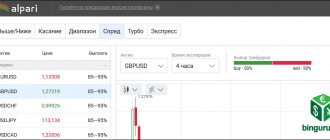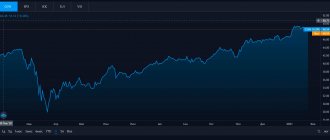In this article, we will explain options trading for beginners, starting with the basics of options trading, and also provide an options trading example to help you refine your trading strategy.
We will also discuss the pros and cons of options trading and explore whether other products such as CFDs (or contracts for difference) would be more suitable for traders in today's market.
The main question for a beginner: what are binary options?
This is a financial instrument that works on the “all or nothing” principle. We need to predict the price movement. Either you increase your income from the bet amount, or you lose it completely. This is such an uncompromising thing.
They trade binary on the AMEX and CBOE exchanges. But only large banks, investment and hedge funds.
Binary options brokers on the Internet are not affiliated with these exchanges in any way. These are not real trades, since transactions are not displayed on the interbank market. But this is good, otherwise we would have to work with a minimum deposit of 10 thousand dollars.
And in binary you can start from 1-10 dollars. We are given a platform where we will predict price movements, receiving a substantial reward for a successful forecast (from 60%), or losing the entire amount of the bet.
All this money is boiled in the broker’s system, successful traders earn money from losers (sometimes fantastic amounts), and losers cry into their pillows. In fact, this is simply financial betting based on the price level.
To avoid becoming a loser, prepare to study for several months. There is no indicator or strategy that will provide you with successful trades in 5 minutes.
There are no freebies here
All the strategies and indicators publicly available on Google will not give you quick access to successful trades. It is useless to look for simple ways here.
To make money in binary, we need 60% of successful transactions. So you have to learn and understand:
- what drives the market;
- how news influences;
- basics of technical analysis;
- and only then the main indicators.
The learning curve is similar to learning a foreign language - nothing works out, something seems to work out, and you slowly start to get the hang of it.
Read the 5 steps of a binary options trader to understand what you'll be up against.
Halva, easy money, the ability to quickly make money using a “strategy” found on Google - there’s nothing here. Well, or you can give your deposit to the broker and, in tears and snot, go into the sunset accompanied by romantic music.
Advantages and disadvantages
Any financial asset has positive and negative sides. Options are no exception. A trader can either earn or lose his money.
Positive sides:
- ease of trading compared to Forex or the stock market;
- fixed profits and losses (with proper capital management, the risk will be a small amount relative to the deposit);
- low entry threshold. It is not necessary to have an account of $100,000 to trade; leverage exists;
- variety of underlying assets. They can be currencies, futures, stocks, or physical goods.
Risks
- Search for easy money. Beginners are attracted by the high potential profit, but they forget about the simple rules of money management and open trades without a clear trading system, which leads to the loss of all their money. The derivatives market is not a casino.
- Brokerage companies that are scammers. Yes, you can learn to trade profitably, but there is a possibility that an unscrupulous broker will not allow you to withdraw money from your account. You should trust only trusted companies (for example, FiNMAX, IB).
- Psychological stress during trading. Beginner traders are exposed to high levels of stress; being in a position causes worries about the outcome of the transaction.
Why are binaries so popular, what's all the fuss?
Well why? There is an interbank international currency exchange market known as Forex. In Russia, hundreds of thousands of traders have been trying to make money on it for many years.
The main disadvantage of Forex is that it is difficult for beginners. Pips, take profits, stop losses, lots... in Forex there are no “rates” as such, and without a stop you can lose your entire deposit in an instant due to a sharp price movement. And even stop loss does not always help. This is a difficult area to learn to predict currency movements from.
Binary or Forex?
And then suddenly binary ones appear, the advantages of which are visible to the naked eye:
- two buttons: you only need to predict the price movement, and not its price level;
- income: from 70% per minute or more;
- adjustable bet size;
- there are no hidden commissions: the broker earns from the difference between the amounts that traders invested and received;
- There are many assets – there are literally dozens of them, not only currency pairs, but also gold, oil, whatever you want.
So if you compare binary with Forex, the latter begins to seriously lose. However, it also has advantages:
- leverage: the ability to trade very large amounts without actually having them on deposit;
- Forex is more flexible in terms of various strategies and trading methods.
So binary ones perfectly complemented Forex and became an opportunity for beginners to make their first forecast on price movement. And new brokers appear every single day.
How does it work in binary options?
Yes, that's it. You need to choose an asset, any one, like a currency pair, and predict where the rate will go and where it will be after a certain period of time.
- Will it go up? Press the “Up” button, also known as Call.
- Will it go down? “Down” button, also known as Put.
Let's say we took the gold rate. Let's bet, say, $100. Let the payout percentage be 72%. We decided that the rate would fall in 15 minutes and pressed the Put button.
We wait 15 minutes and if the forecast was correct, $172 will appear on our account. And if it’s not true, we lose our $100.
Do you see how? Risks and opportunities. We can earn a crazy percentage very quickly - not 6% per year in a bank, but from 70% in a few minutes. But the RISK is very significant.
However, with all brokers you can minimize the risk by specifying the amount that will be returned to you if the forecast is unsuccessful. So you can still get part of your bet back.
The essence
Options offer investors alternative strategies to profit from trading the underlying securities. There are many strategies that involve various combinations of options, underlying assets and other derivatives. Basic strategies for beginners include buying calls, buying puts, selling covered calls, and buying protective puts. Trading options have advantages over the underlying assets, such as downside protection and leveraged returns, but there are also disadvantages, such as the requirement to prepay insurance premiums. The first step to options trading is choosing a broker. Luckily, Investopedia has compiled a list of the best online options trading brokers to make getting started easier. (See also "5 Best Books on How to Become an Options Trader").
Search by alphabet
LANGUAGES
| | | |
- Investing Coca-Cola and Pepsi offer nice dividends
- CIVETS (Colombia, Indonesia, Vietnam, Egypt, Turkey and South Africa)
- Captive fund
- Buy and homework
- Black-Litterman model
- Ex-dividend date vs record date: what's the difference?
- 10 Most Expensive Cyberattacks of All Time
- Company earnings and earnings per share: everything investors need to know
- Primorskaya land
- Market Capitalization vs Market Value: What's the Difference?
- Valuing Stocks Using Supernormal Dividend Growth Rates
- Star
- Is short selling prohibited in China?
- Reduce capital risk
- How safe is it to send money via Facebook?
- Introduction to Commercial Paper
- Flipping
- Cyber and Privacy Insurance
- Market selection
- CDO-Cubed
Trend up or down: bulls vs bears
In general, the ability to predict prices is studied by such a thing as technical analysis. At the end of the article I will link to a very cool book on this topic, but for now let's learn the basics right now.
There are two types of traders in financial markets: bulls and bears. They constantly fight each other.
- Bulls are buying up (imagine them constantly pressing the “Up” or Call button)
- Bears are short (these ones love the “Down” button).
Depending on who wins – the bulls or the bears – the rate of our asset changes.
Here's a good example to remember:
How can we watch the fight between bulls and bears? On a line chart or on a chart with Japanese candlesticks.
Line graph
Japanese candles
Don't believe in freebies
All binary options brokers attract new clients with incredibly easy earnings. However, the reality is much less optimistic. The number of unsuccessful traders will always significantly exceed people who have achieved success in this field. Otherwise, such financial activities will cease to bring profit to their creators.
To obtain a stable profit, the trading system used by a trader must have an efficiency of at least 60–65%. Otherwise, you simply will not be able to cover the loss from unsuccessful trades.
In addition, you should understand that most trading indicators and strategies that are freely available will not be able to provide the trader with a stable income without your individual modification and tweaking.
If you want to get guaranteed high results, you will have to understand:
- with the reasons and directions in the movement of financial markets;
- the impact of news on stock trading;
- fundamentals and methods of technical analysis;
- selection and individual configuration of trading indicators.
Only by independently going through the described path from beginning to end can an investor achieve success.
Live chart and trading tools
Well, since assets have a rate, you have to look it up somewhere, right? Most brokers show it only schematically. There are also brokers that have their own schedule, like IQ Option, but it is very inferior to its professional counterparts.
Therefore, we will open a normal chart in one window, and in the second we will press the broker’s buttons.
On the left is a live graph . On the right is the chart of the IQ Option .
What free, normal schedules can you recommend for work? One of them is presented on the website - a live chart via the link in the top menu. It's the same:
- TradingView;
- FreeStockCharts;
- Metatrader;
- ThinkOrSwim (for experienced ones);
- NinjaTrader (similar).
Trading chart
For the convenience of trading, it is customary to track quotes of the underlying asset within the framework of trading charts. This method is the most visual and convenient. Each of the binary options brokers on the market offers its clients its own version of such a chart. However, their problem is that these electronic trading platforms have an extremely meager set of technical analysis indicators.
To solve this problem, most professional traders resort to the following trick. They get used to working on at least two windows. The first displays the website of their brokerage company, where they only make transactions. The second displays a full-fledged live graph.
A legitimate question arises: where can I get it? We recommend our readers to get their own version of free trading for exchange trading Meta Trader 4. It has a live chart in its arsenal that fully meets all the highest requirements.
In addition, you can use several free online services:
- TradingView;
- FreeStockCharts;
- ThinkOrSwim;
- NinjaTrader.
Japanese candlesticks and binary trading
In order for your trading to go smoothly, you need to figure out what the chart is showing us. And he shows us Japanese candles.
This concept is not difficult at all. A candle is the price movement over a certain period of time. She has a body and shadows - a maximum and minimum price.
Candles come in different colors:
There are also candles that you need to pay special attention to:
- A) Doji: The opening and closing prices of the candle are the same. Be careful - the price does not yet know where it will go.
- B) Long-legged Doji: if it appears after small candles, the course will soon reverse.
- C) Zero Doji: The opening and closing prices are the same. We ignore such things altogether.
Reviews
Reviews from beginners and experienced traders are divided. Some are sure that working with options, in particular with binary ones, is a scam, others shout about super profits. Which of this is true and whether all opinions are real is up to you to judge.
Best time to trade binary options
One of the important aspects of binary trading that a beginner should know about is trading timing. Of course, trading options, currency pairs, indices and the like is carried out 24 hours a day, 5 days a week. However, not every minute is worth entering into a trade.
There are times and days of the week when the pair has greater volumes and liquidity, which is reflected in its volatility, that is, how active, vigorous and fresh the rate is. And where there is more activity, there are more opportunities to enter into a deal.
Intersection of time intervals
The foreign exchange market is most active when sessions of different exchanges intersect. It is during this period that couples demonstrate active movement.
The time shown in the diagram is Greenwich Mean Time, GMT. For Moscow time just add +3.
When several markets are active at once, volatility increases and the price takes on a clearly defined movement. But during off-peak hours there is often a flat market. This is the so-called “consolidation period” during which, by the way, I made most of my money in BO.
Right time
We, binary options traders, make money by predicting price movements. Therefore, volatility or its absence is very important to us.
We see that a good time, according to Moscow, is:
- 11:00 – 12:00 (Tokyo/London);
- 16:00 – 19:00 (London/New York);
- 3:00 – 9:00 (Sydney/Tokyo).
Research shows that the most active trading hours take place during the European session (see London). Also in the USA at 16:30 Moscow time, important economic indicators are often published, which greatly influence trade.
Nonfarm payrolls: important news of the month
Every first Friday of the month in the United States, data on the number of people employed in the non-farm sector is released. They are also known as NFP (Nonfarm payrolls).
This is one of the key news every month.
If this indicator grows, the dollar exchange rate also rises; if not, it falls. This data ALWAYS affects all exchange rates where USD is present. In pairs such as EURUSD, USDCHF and many others. Very important news, look at it always and everywhere.
You can watch the news on a live chart or in economic calendars .
If NFP data is positive, the dollar usually strengthens; if not, it sinks. Always follow this news. Or don’t trade it at all - all this is described in the BO school.
Best days of the week to trade
There are days when the price is more pleasant for trading. This Tuesday and Wednesday are definitely the best times. Friday also performs well , especially when European trading hours overlap with American ones (from 16:00 to 19:00 Moscow time). on Monday , but not in the early hours.
But after 7 pm on Friday, there is no need to trade anymore - the markets will soon close and the price will get up to hell.
How to trade options on the stock exchange
We figured out what you need to do to start trading. The main component of the success of any trader is the right strategy. Now I will tell you in simple words about popular trading systems.
Popular trading strategies
Straddle. One of the simplest strategies. If a consolidation breakout and high volatility are expected, call and put contracts are purchased simultaneously. It doesn't matter whether it's up or down, all that matters is that there is movement.
Sold butterfly. Suppose a range has formed on the chart. At the edges, 1 call option is sold, and in the middle, 2 put options are bought. For example, 10 call options with a strike of 75,000 are purchased and 5 call contracts with a strike of 80,000 and 5 with a strike of 70,000 are sold. An important detail is the same expiration time for these derivatives. Below I give a graph of profit/loss when trading using this strategy.
Strangle. It is similar to a straddle, but the purchase of call and put options is not made at the same level, but at an arbitrary distance from each other. The potential profit from trading is higher than with a straddle, but you need to catch really powerful movements.
How to correctly calculate the purchase volume of an option so that you are not closed by a margin call broker
Trading futures contracts has the same rules as any other instrument. Money management is an integral part of any trading strategy.
Beginners are advised to adhere to the rule: the loss from a transaction should not exceed 1–3% of the deposit. Many novice traders try to achieve excess profits in trading and use large volumes, forgetting about this rule.
Even a profitable strategy in this case can lose your deposit due to a series of unsuccessful trades (which is an integral part of the market).
Options trading as an example
To trade, you need to install the platform (for example, consider the QUIK terminal). The first step is to set up your options board. After the basic settings, you need to click on “Create window” - “Customize menu”.
On the left we find the button “Futures and options” – “Options board” – “Create window”. Let's take the RTS index option as an example. Each contract has a code.
A set of letters and numbers (for example, RI78500BD6) reflects the main characteristics of the option:
- RI – RTS (underlying asset code);
- 78500 – strike;
- B – type of calculations;
- D – month of execution and type of option (put/call);
- 6 – year.
The following parameters are indicated in the desk: theoretical (informative) and real price (based on supply and demand), strike, BA price, expiration time (+ volatility).
It is important to consider the price (premium) of the option. It is necessary to calculate the break-even point (for example, when buying a call derivative with a strike of 8000 and a premium of 300 rubles, profit will only come after the price passes the 8300 mark).
What is the best expiration time?
In binary options trading, the timing of the transaction - that is, expiration - is a very important factor.
As a rule, all traders choose a period from 60 seconds to 30 minutes. Let's look at them briefly.
Expiration is the end time of the transaction, which we choose from the broker.
A timeframe is a time interval on a price chart.
In the broker window (in this case, IQ Option), we select the expiration time. The time for which we make a forecast and after which our transaction will be closed.
But on the price chart, as in the example below, we select a time frame. Let's say if we chose 5 minutes, then each candle on the chart will indicate a price movement during these 5 minutes.
The longer the timeframe, the more understandable the price movement will be, since this is how market noise is “filtered out.”
Expiration 60 seconds
A very unpredictable period of time. Quick results, but predicting price movements is extremely difficult. It's more like gambling than trading. But there are people who earn money this way. Their chart is on a 1-minute timeframe.
Expiration time: 10 to 15 minutes
During this period, the price can sometimes turn in the other direction. To figure this out, use a live chart set for 5 minutes.
Expiration 30 minutes
Perhaps the optimal expiration for trading. Economic news must also be taken into account here. Half an hour is enough time for the asset to begin moving confidently in the predicted direction.
In this case, you must definitely look at the news, as well as the chart at 5-15 minutes and 1 hour, in order to understand how best to enter a deal.
Which timeframes best show the trend - price movement?
To find the price movement, which is displayed through Japanese candlesticks, we need a large time frame.
As a rule, it is at least 1 hour. However, traders who prefer short-term transactions can choose 5- and 15-minute ones.
In this case, the 1-minute chart is used to find the exact entry point into the trade, but on the 5- and 15-minute chart we confirm both the trend and draw support and resistance lines.
If you trade with expiration from 15 to 30 minutes, then 1- and 4-hour charts are well suited for analyzing price movements.
Covered call
This is a preferred position for traders who:
- Don't expect changes or slight increases in the price of the underlying asset
- Willing to limit upside potential in exchange for some downside protection
A covered call strategy involves buying 100 shares of the underlying stock and writing a call option against those shares. When a trader sells a call, the option premium is charged, thereby reducing the price of the stock and providing some downside protection. In turn, by selling an option, the trader agrees to sell shares of the underlying asset at the option strike price, thereby limiting the trader's upside potential.
Let's say a trader buys 1,000 shares of BP (BP) at $44 per share and simultaneously writes 10 call options (one contract for every 100 shares) with a strike price of $46 expiring in a month, for a price of $0.25 per share, or 25 dollars. per contract and $250 for 10 contracts. The $0.25 premium reduces the stock's underlying price to $43.75, so any decline in the underlying to that point will be offset by the premium received from the option position, providing limited downside protection.
If the stock price exceeds $46 before expiration, the short call option will be exercised (or "called"), meaning the trader will have to deliver the stock at the option's strike price. In this case, the trader will make a profit of $2.25 per share ($46 strike price – $43.75 basis price).
However, this example implies that the trader does not expect BP to rise above $46 or significantly below $44 over the next month. As long as the stock does not rise above $46 and is called before the options expire, the trader will keep the premium free and clear and can continue to sell calls against the stock if desired.
Risk/reward: If the stock price rises above the strike price before expiration, the short call option can be exercised and the trader will have to deliver shares of the underlying asset at the option strike price, even if it is below the market price. In exchange for this risk, the covered call strategy provides limited downside protection in the form of the premium received when selling the call option.
Binary options strategies for beginners
Of course, you are eager to learn about strategies that allow you to trade successfully. Let's say right away - there is definitely no .
There are a great many of them, and you can succeed in them only if you skillfully operate with different time frames, use various indicators and spend a lot of time watching how the price develops.
But do you have to start somewhere? Here are 5 strategies to get you started.
Double red candle strategy
This short-term strategy is based on a resistance line. Trading is carried out on a 5-minute live chart.
The signal we need is when 2 red candles bounce off the conventional line at the top. We enter a trade on the 3rd candle down (Put button).
- We are waiting for the first candle.
- We are waiting for the second red candle.
- If the second red candle closes lower than the first, that’s great.
In this case, the third, as a rule, will be even lower than the second.
- Expiration time: no more than 15 minutes;
- Time on chart: 5 minutes.
Exceptions:
- not suitable for too high a price;
- do not use when important news comes out.
“Pinocchio” strategy
In the USA, it is called, of course, the Pinocchio Pinocchio strategy - this is a candle with a very small body and a very long shadow - that is, the nose.
Pinocchio strategy - this is a candle with a very small body and a very long shadow - that is, the nose.
This candle is loved by all traders and is called by several names: Shooting star, Hanging man, Hammer and Inverted Hammer.
As you remember, Pinocchio’s nose grew when he began to lie shamelessly. So it is here, if the shadow (nose) is significantly longer than the body of the candle, therefore, the market is deceiving us, and we need to trade in the opposite direction.
Where exactly to enter a trade, you will determine with practice. It is not uncommon for traders to wait for the next candle after Pinocchio, while others enter a trade immediately after the Pinocchio nose candle has closed.
If the nose is looking up, the price will soon go down and vice versa, if the nose is down, the price will go up.
- Time on the chart: from 5 to 15 minutes;
- Expiration: 1-1.5 hours.
Exceptions:
- do not use the 1-minute chart;
- do not trade on a “flat” market; the real Pinocchio signal comes when there was an upward price movement before it.
Pinocchio may not be lying if the price has not moved anywhere before - so be careful.
Strategy “3 peaks”
A very popular strategy described in hundreds of books on technical analysis. She looks like this:
- After the price has risen briskly, look for 3 tops as shown in the figure. You need to start, of course, from peak number 1.
- After the first peak, we look for the second one – number 2.
- If the new upward movement does not exceed top 1, and turns down, this is how top 3 is formed.
- When the price falls below top 2, it is time to buy a Put option.
- Expiration time: depends on which chart timeframe you saw this pattern on.
- Exceptions: it is better to open 2 transactions with a shorter expiration time than one, but with a very long one.
Signal strategy
Absolutely useless in itself, because signals by themselves do nothing. However, they can save time because they are a banal mechanical forecasting system.
Below the live chart is an example of such a technical system.
The point here is clear - instead of throwing dozens of indicators on the chart, investing has already done it for you. All that remains is to open the chart and, focusing on the metrics, decide what to do next.
- Actively selling is a signal that the price may go down.
- Actively buy - the price may go up.
Pay attention to the “maybe” - these are not signals as such, but simply an indicator system. There is no need to work strictly on it .
Forecasts on TradingView
The full version of the tradingview.com chart, where you can register completely free, has a ton of useful information and several tens of thousands of traders who share their forecasts completely free of charge.
This is not just one of the best charts on the planet, but also the best social network for traders. And there are… tons of forecasts out there.
Top 3 Indicators for Beginner Traders
In addition to a live chart, candles and strategies, we need indicators, right? They are selected in the live chart using the Indicators button.
What indicators can be recommended:
- Relative Strength Index (RSI);
- Stochastic;
- Bollinger Bands.
Read the description carefully and you will immediately find excellent opportunities for their use.
Other strategy options
These strategies may be a little more complex than simply buying a call or put, but they are designed to help you better manage your options trading risk:
- Covered call strategy or buy- sell : a stock is purchased and the investor sells call options on the same stock. The number of shares you purchased must be identical to the number of call option contracts you sold.
- Spousal put strategy: After purchasing a stock, the investor buys a put option on an equivalent number of shares. A pooled put works as an insurance policy against call options for short-term losses at a specific strike price. At the same time, you will sell the same number of call options at a higher strike price.
- Protective Collar Strategy: An investor buys an out-of-the-money put option while simultaneously writing an out-of-the-money call option on the same stock.
- Long Straddle Strategy: An investor buys a call option and a put option at the same time. Both options must have the same strike price and expiration date.
- Long choke strategy: The investor simultaneously purchases a call option and an out-of-the-money put option. They have the same expiration date but different strike prices. The put strike price must be lower than the call strike price.
Best book for beginners
The best book for the future binary options trader was written by the CEO of Reuters, the most famous financial news agency in the world.
However, Thomson Reuters is also one of the three leading quote providers used by brokers and live charters around the planet.
Who else but them should know where to start? Be sure to use this source, only 160 pages, and everything is to the point.
The most popular indicators
Currently, a huge number of indicators for technical analysis have been invented and are actively used by traders for trading binary options. Moreover, most of them were originally created as a tool for classical stock trading.
For beginners, we first recommend that you familiarize yourself with the following indicators:
- moving average;
- Bollinger Bands;
- Stochastic.
Having mastered these tools for technical analysis, you will be able to move much faster towards receiving a stable income.
No freebies, go for a walk, boy
Realize right away - on the charts you see the movement of currencies on the international interbank foreign exchange market. Our trades are not based on it - but we place bets on this movement.
If you decide that you can just predict the movement of the euro, dollar or yen on the interbank market, think again. Nice. It should dawn on you that only a currency analyst can make such forecasts in a stable, positive manner.
Are you ready to become one? Are you ready to spend six months to a year on training, practice, everyday trading, and working with your psychology? If so, good luck.
If not, you have only one prospect: drain your deposits and walk off into the sunset in snot. Decide what you need in advance. And don’t expect miracles - all miracles depend strictly on you, and not at all on books, signals, indicators or sites like this.
Why sell options
The buyer is at a somewhat disadvantageous position. When opening a deal, a premium is paid. To gain profit, the increase in the price of BA must cover the payment to the seller.
Suppose a Call option was sold (BA - futures on Rosneft ) with a strike price of 36,000 , the premium on it was 500 rubles . During expiration, the price of securities increased to 362 rubles , which means that when the holder exercises the right to purchase BA, he will earn 200 rubles. , which partially covers the loss due to the premium. The seller in the same situation earned 500 – 200 = 300 rubles .
The relationship between the profits of participants in a Call option transaction is illustrated in the graph below. As soon as the price of the BA exceeds the strike , the buyer’s profit begins to increase, while the opposite side’s loss increases.
For Put contracts, the type of chart changes.
The condition of sellers of Put and Call options critically depends on the price of the underlying asset . At the moment the deal is concluded, he is in a more advantageous position, but over time the situation can quickly change.
Mobile trading
Almost all brokerage companies where binary contracts are traded provide their clients with opportunities to use mobile trading. This is a very convenient feature, since you don’t always have access to a computer or laptop. You don’t even need to specifically study how to trade binary options from your phone, since there is no difference between computer and mobile trading. The only thing a trader needs is to install a special trading platform on his phone, select a broker and enter his login information.
According to traders, trading from a mobile device is not very convenient, as some functions are limited, but all the basics for trading are available. That is, you can use some trading instruments, open and close positions, replenish your account and withdraw profits.
Mobile trading has one big advantage - you can trade anywhere and at any time, as long as you have access to the Internet. For example, while walking, in queues, during lunch breaks or while relaxing in nature.
Choosing a trading strategy for trading
Each trader, after completing a basic training course, chooses the most suitable trading strategy for him. All trading techniques are divided into several groups:
- for short-term transactions;
- for long-term positions;
- for mid-term or intraday transactions.
The first option includes positions with expiration times from several minutes to several hours. Long-term deals can even last several months. In addition, trading strategies are divided by aggressiveness; the higher it is, the greater the financial risks.
For beginners, professionals advise using classic trading strategies, with risks of no more than 1%, maximum 2% of the deposit. Whatever tactic the trader chooses, before starting to use it, it is necessary to carefully study the features of the trading strategy and the descriptions of options that are recommended for this technique, since they all have different specifics.











